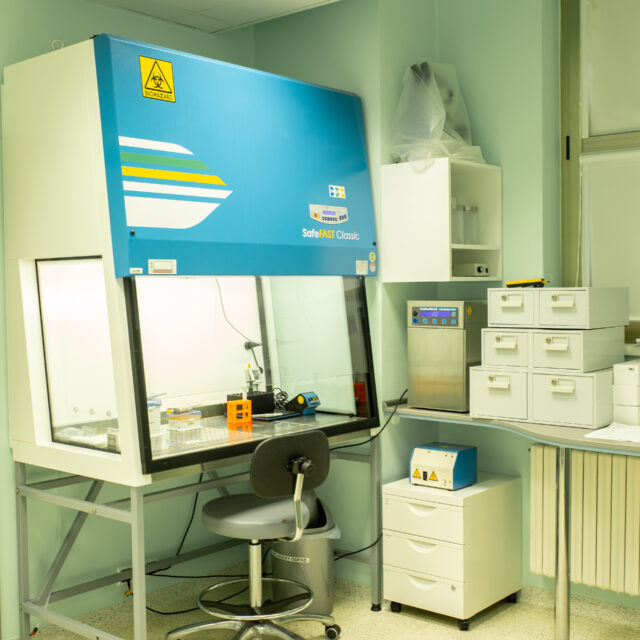Special laboratory methods

IMSI (intracytoplasmic injection of morphologically selected sperm)
In this method we use a special microscope – which has a high magnification (6,000 x) and is used in the detailed evaluation of the sperm.
Extended Cultivation (EC)
Embryo cultivation in laboratory conditions is most often 3 to 5 days from the day of egg collection. Today, 5-day cultivation is mainly used, as it enables the control and subsequent selection of the most suitable embryos for transfer (transfer to the uterus).
Determining the optimal day for embryo transfer is completely individual and may vary when repeating an IVF cycle.

Assisted hatching (AH)
Assisted hatching is a micromanipulation technique influencing the success of infertility treatment. The embryo develops to a certain size under a hard shell. If pregnancy is to occur, the embryo must leave this covering (zona pellucida) after being transferred to the uterus and nestle in the endometrium.
In some women, embryo implantation may fail due to a too firm or thick zona pellucida. Using a micropipette, the envelope is gently cut and the path for the embryo is cleared. During assisted hatching, the embryo cannot be damaged.
The embryologist decides whether this method will be used, based on the assessment of the development of the embryo and the consent of the treated couple.
Hormonal treatment
Hormonal treatment (stimulation) is used to treat infertility, which causes more eggs to develop and mature in the ovaries. The doctor decides on the start of the stimulation and the duration of the administration of hormonal preparations based on the findings of the examination and the health status of the woman.
The doctor monitors the course of ovarian stimulation with ultrasound. During this examination, he evaluates the height of the endometrium, measures the size of the follicles (cavities with fluid in which the egg develops), checks their number and possibly monitors the levels of hormones in the blood.
EmbryoGlue
EmbryoGlue is a special culture medium designed to transfer embryos directly into the uterus. This medium contains all the nutrients and energy sources for optimal embryo development. It also contains – in a higher concentration the substance hyaluronan, which is normally found in the follicular fluid in the fallopian tubes and in the uterus, where it creates an environment with increased viscosity.
Using EmbryoGlue medium during transfer to the woman’s uterus increases the chance of pregnancy compared to using medium without hyaluronan. The culture medium can be used for both fresh and frozen embryos.
EmbryoScope – time laps system – MIRI
EmbryoScope is a device consisting of an incubator, a microscope, a camera and a computer, which enables continuous monitoring and evaluation of the development of embryos. All this without the embryologist interfering in any way in their environment. Everything is recorded on the computer in a special program.
This incubator records images of each stored embryo in multiple planes every 10-20 minutes.
The following parameters can be monitored and evaluated using this device:
- exact determination of the time of the first division of the embryo and its subsequent divisions
- morphology of pronuclei and nucleoli
- structure and location of the polar body
- appearance of cytoplasm
- fragmentation process
- number, shape and symmetry of blastomeres
- formation and number of nuclei after division of the embryo
Sperm DNA fragmentation test - HaloSperm test
Up to 15% of men are considered infertile, despite the fact that they do not show deviations in the standard evaluation of the spermiogram. The reason is excessive fragmentation of sperm DNA, which fundamentally reduces the chances of successful fertilization and subsequent development of the embryo. The HaloSperm method enables a deeper evaluation of sperm quality and complements conventional sperm analysis – a spermiogram, where only the concentration, mobility and morphology of sperm are evaluated. The Halosperm test examines the integrity of the sperm DNA molecule.
- For successful fertilization and subsequent development of the embryo, one of the conditions is undamaged DNA, which is stored in the sperm head
- Sperm with damaged DNA may look and move normally, so they cannot be detected by routine examination
- The method enables the visualization of sperm that contain degraded DNA thanks to a high-contrast substance
The method is recommended for:
- men older than 40 years
- to couples with a history of spontaneous abortions
- men with cancer, especially after chemo or radio therapy
- men who are exposed to toxic substances (e.g. at work)
- men who take long-term prescription drugs
- to couples with an unknown infertility factor
Embryotransfer (ET)
During embryo transfer, embryos are introduced into the uterine cavity. The transfer of embryos to the uterus is performed with a thin transfer catheter, and for the patient it is an undemanding and painless procedure, similar to a regular gynecological examination.
The embryologist and the doctor decide on the number of transferred embryos. This is based on an assessment of the development of the embryos taking into account the course of previous IVF treatment, the patient’s state of health and her age. In doing so, the wishes and above all the consent of the treated couple are taken into account.
One to a maximum of three embryos can be introduced into the uterus.
Cryoembryo transfer (KET)
Cryopreservation allows embryos to be stored in a frozen state (-196 °C / -320 °F) for later use.
During cryoembryo transfer, the embryos are thawed and their quality is assessed. And after short-term cultivation, they are introduced into the uterine cavity with a thin transfer catheter.
The procedure is easy for the patient, painless and similar to a regular gynecological examination.


